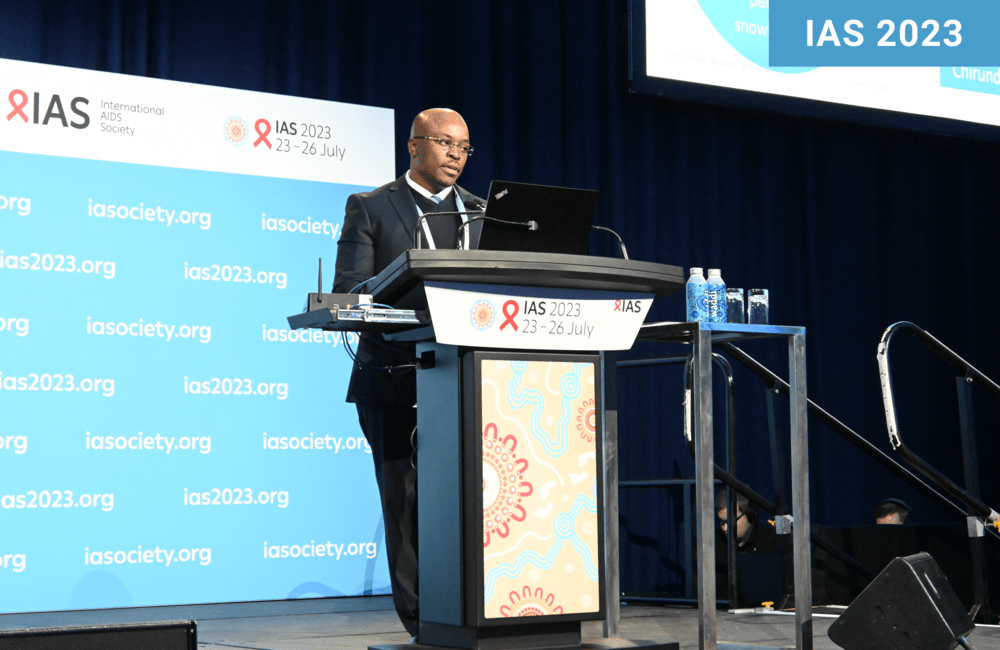
A peer-to-peer method to increase PrEP use among female sex workers in Zambia was highly effective, resulting in 97% new PrEP uptakes, compared to only 22% for the routine approach, the recent 12th International AIDS Society Conference on HIV Science (IAS 2023) heard.
Dr Kalasa Mwanda from USAID shared that in the first month, 48 female sex workers already using pre-exposure prophylaxis (PrEP) were trained to provide messaging about PrEP and encourage their peers to take it. By the sixth months, 1140 sex workers had been reached and 97% of those who did not have HIV were initiated on PrEP.
In Zambia, more than half (56%) of female sex workers are living with HIV. Despite this, in the Chirundu border town – a transit point for truck drivers and a hub for sex work that is shared by Zambia and Zimbabwe – only 22% of sex workers who tested negative have opted for PrEP, which is much lower uptake than elsewhere in Zambia.
Over six months, USAID CHEKUP embarked on an initiative to engage and train sex workers in Chirundu already accessing PrEP to identify peers in their network, provide PrEP messaging and encourage them to take up PrEP.
Five healthcare professionals trained 15 community health workers to provide PrEP messaging. These community health workers then reached out to 48 sex workers in the first month, referred to as 'tier 1', and provided them with training and guidance on recruiting their peers. By the third month, the tier 1 sex workers had recruited 120 'tier 2' peers, who then engaged other sex workers.
Both tiers underwent the same messaging and training, which included sharing their personal experiences on the benefits of PrEP and addressing common concerns. They were also taught how to refer individuals to the nearest outreach point for PrEP linkage.
After six months, the tier 1 and tier 2 sex workers successfully contacted and recruited 1140 of their peers. Out of these, 4% were found to be HIV positive and were already receiving treatment, while 8% were newly identified as HIV positive and were connected to treatment. The majority of those who tested HIV negative (97%) started on PrEP, while 3% said they were not ready.
Most of the female sex workers that took up PrEP were in their twenties, which was similar to their PrEP-promoting peers. Being spoken to by someone 'in my situation and also taking the medicine' (85%) and 'them making it convenient for me to access the medicine' (71%) were the prominent reasons the new recipients gave for them to be initiated on PrEP.
Responding to a question on PrEP persistence, Dr Mwanda acknowledged that retention decreases to around 20 to 25% in Zambia's general population after about nine months from initiation. However, he expressed optimism about the persistence rates for their project.
“Under our project, there is a lot of support, and we champion base-of-pyramid approaches, with more contacts between community health workers and the sex workers, so our projection, even as we get to nine months, is that it will be way higher than the general population,” he said. “We have a model where each recipient of care has a go-to community health worker who is responsible for checking when their PrEP medication is due for collection and checking on them. This greater support is likely to yield a better persistence result going forward.”
The researchers concluded that the peer-to-peer model has the potential to increase both the acceptability and uptake of PrEP among sex workers, and that other programmes should adopt this model, particularly for individuals who face a greater risk of contracting HIV and may not typically seek HIV prevention services.
Likewise, a clinic in the neighbouring country of Malawi used a related approach – but this time PrEP users contacted their sexual partners.
Between 2022 and 2023, Claire Pedersen of the University of North Carolina and colleagues enrolled 175 individuals starting oral PrEP at a public sexually transmitted infections clinic in central Lilongwe. The median age of the participants was 27, a majority (62%) had been diagnosed with an STI, 63% were male, and 23% were adolescent girls and young women.
Using Assisted Partner Notification, a World Health Organization-backed strategy of tracing and offering testing to sexual partners of people diagnosed with HIV or STIs, participants voluntarily shared information about their recent sexual partners.
Almost half (49%) of the participants provided contact information for 100 sexual partners. The clinic staff then contacted the partners who didn't show up within 14 days. Of the 100 partners, 58 returned for care and were screened for PrEP eligibility. If they were eligible and interested, they were enrolled in the study and started on PrEP.
Of the 58 partners who returned to the clinic, 34% were HIV positive and ineligible for the study. Among the eligible partners, 71% started on PrEP, while 29% declined PrEP and/or the study procedures. The median age of the enrolled partners was 26, and the majority (74%) were female.
This study demonstrates that engaging young heterosexual men in PrEP care at STI clinics is an opportunity to prevent HIV transmission and may be particularly powerful when coupled with PrEP referral for female partners.
Mwanda K et al. Snowballing peer-to-peer model - a silver bullet for improved PrEP uptake among FSWs in Zambia's border town of Chirundu. 12th IAS Conference on HIV Science, Brisbane, abstract OAE0104, 2023.
View the abstract on the conference website.
Pedersen C et al. Integration of PrEP services and assisted partner notification into an STI Clinic in Lilongwe, Malawi. 12th IAS Conference on HIV Science, Brisbane, abstract OAC0205, 2023.
